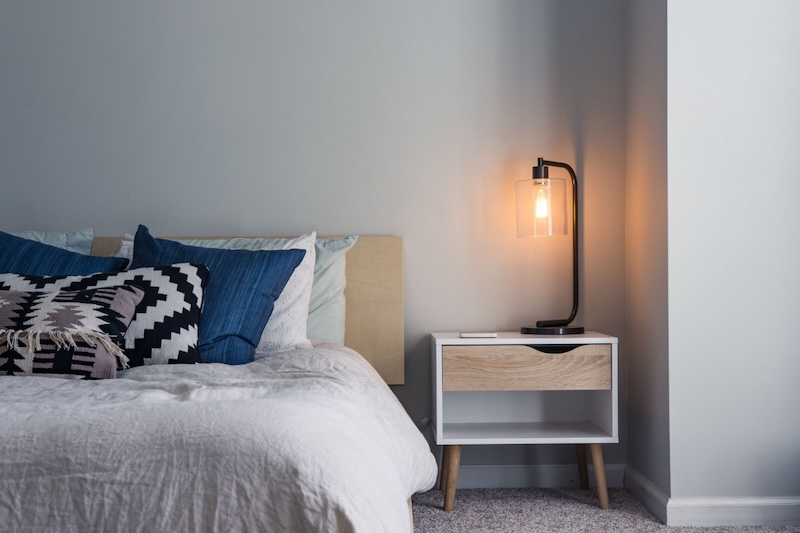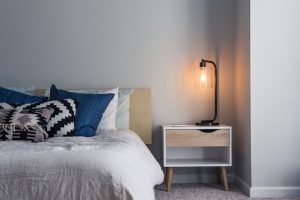Skip to content




When you think about the most important factors of keeping seniors happy and healthy at home, you may not be thinking about ideal bed height. But in fact, determining the right bed height can have a major impact on home safety and in particular, bedroom safety. The National Council on Aging reports that about 25% of elderly people over the age of 65 experience some sort of fall each year.
And while falls are a major health risk for anyone, they are especially concerning for seniors.
Every year, 3 million older adults are treated in emergency departments for injuries related to falling. Those falls lead to over 800,000 hospitalizations due to fall injuries each year. Many of those include hip fractures and head injuries, which are extremely serious injuries that affect not only quality of life, but death rates among older people.
And while there are a range of places within the home where falls can occur, in the bedroom, and especially in or near beds, is an area of concern. In this blog, we’ll not only talk about the literal best bed height for seniors, dipping into things like traditional beds versus low beds, adjustable beds, and what to look for when buying a new bed, but we’ll share some additional bed safety tips that can help address some specific needs or concerns.
Then, we’ll provide some advice to help you keep your loved one safe from bedroom falls and happy at home. And while there is no “best bed” for everyone, we hope that this guide helps you identify what’s most important for your specific needs when choosing a type of bed.
Why is bed height and bedroom safety so important for seniors?
Sleep health and quality is important for every adult’s mental and physical health – we all recognize the importance of a good night’s sleep! And any potential health risks are dangerous for everyone, but are especially magnified for seniors. Sleep quality is such an important factor that impacts lifestyle diseases like obesity, type 2 diabetes, high blood pressure, and heart disease.
All of these are among the top contributors to early death in seniors. Choosing the best beds for specific needs is important to get high-quality sleep, and also to prevent circulation issues. Older adults in particular (especially seniors with chronic medical conditions) are at an increased risk of circulation issues.
Those issues alone can hurt the quality of sleep and the quantity of sleep seniors get each night. But also, a comfortable bed can help alleviate joint pain and help seniors move into different positions as needed. When a bed is too high or uncomfortable, it can limit a senior’s ability to move around as needed.
Older seniors with more serious health issues also tend to spend a lot of time in bed, which can lead to serious health issues like pressure ulcers and dermatitis (this is especially important for seniors who suffer from incontinence). And lastly, the ability to easily get in and out of bed can play a big role during household emergencies. For example, seniors are nearly 4x more likely to die in fires than the general population. Here at LiveBetter at Home, keeping seniors and others safe and happy at home is what we do, which is why this topic is so important to us!
What bedroom risks can affect senior health?
While we’ve touched upon why bed height is important, let’s take a minute to walk through bedroom risks that are especially important to monitor for seniors and those with disabilities.
Bed falls, as we’ve touched upon, are a high risk for seniors. These can occur while getting and out of bed, and even while sleeping. Seniors with mobility issues, or those taking certain prescription medications (especially at bedtime) are at an especially-high risk for balance issues that can lead to falls.
Falls throughout the bedroom can occur from too much furniture, clothing or other items on the floor, rugs, poor lighting, and general motility issues.
Circulation issues and risks increase as we age. Staying in the same position for an extended period of time (such as in bed, while watching tv, and as we more often hear, while in a plane) can lead to serious and life-threatening issues like blood clots, bed sores (pressure ulcers), swelling, and even infections like cellulitis due to impeded blood flow.
Bedroom cleanliness & hygiene can be impacted when older adults are unable to keep up with household tasks. Clean bedding is especially important, particularly for those with incontinence issues or who spend an extended period of time in bed. Skin infections and respiratory issues are particular risks from soiled or improperly-changed bedding.
Fires are a risk for everyone, but for older adults and those with mobility issues, they can be especially deadly. Fire risk can be lessened with some small household upgrades, and properly organizing and cleaning the bedroom can make it easier and safer for seniors to move to safety in case of an emergency.
What is the actual best bed height for seniors?
The importance of bed height can be critical for preventing injuries, and knowing the right height for elderly patients and individuals who want to be safer in their homes is important. While there is no perfect bed height for everyone, the Americans with Disabilities Act recommends a bed height of 20″ to 23″ for seniors.
A lower bed height can help make it easier for seniors, and especially those with mobility issues, to get in and out of bed without any difficulty. Still, though, this may present some difficulties for older couples with different heights. Or, the specific, low height for an individual can vary based on their own height.
There are many advanced features available today that were either hard to come by in the past, or even unthinkable. Everything from a smart base that is adjustable from your smartphone, to USB ports that allow you to charge your phone from right in your bed.
An adjustable bed frame can be a good option for those who aren’t sure what height they need, for couples, or even for an older adult who doesn’t have much difficulty now, but has some health problems and anticipates needing to lower the height of the bed in the future. Think about hospital beds, and why they’re used so widely. Medical personnel can maneuver an adjustable base as necessary to help patients get in and out of bed, or for medical staff to move patients.
Other adjustable beds tilt up to also make it easier to get in and out of bed, or lower the edge of the bed for the same reason (versus simply going from lying down and trying to get out of bed and stand at the same time). These beds typically come with a remote control, making it easy for seniors to control the bed height and other factors from safely within bed.
Another factor impacting the overall height of a bed is the mattress thickness. Removing mattress toppers and choosing a shorter mattress is an easy way to lower bed height (although, it’s important to weigh the balance of comfort with bed height – a combination of changes may be necessary to reach the perfect balance of comfort, function, and safety). And some of the best news about special (and even high-tech) beds is that many come with a trial period, so that you or your loved one can be sure that it is the right bed for their needs before making a final decision.
If budget is an issue and you need to lower your bed height without spending much money, and in a way that’s relatively easy, consider removing your box spring. Box springs can add 6″ or more to the height of a bed, and removing it from taller beds can immediately lower overall bed height.
Removing bed risers and mattress toppers can also help with low bed height. If you do decide to remove your box spring, then switching from standard bed frames to platform beds will be essential to ensure you or your loved one is getting the right amount of support from their bed and mattress. Step stools are still another inexpensive way to essentially “lower the height” of a bed for a shorter person or senior who needs the bed especially low. While it won’t actually lower the height, it can help bring you or your loved one “up” to meet the bed.
What are some additional ways to prevent falls or other health concerns from beds?
While choosing the right bed and bed height are critical to bedroom and bed safety for seniors, there are other steps you or a loved one can take to stay safe. Minimizing clutter in and around the bed can play a big role in preventing falls or tripping. Keeping excessive books, snacks, blankets, and pillows out of the bed can help ensure seniors have the ability to move into their favorite positions while also meeting their comfort preferences.
While some falls happen getting in and out of bed, some seniors also fall out of bed during the night. To minimize the risk of serious injury from falls that do occur, adding soft cushions to the edges or corners of any nearby furniture, including dressers, night stands, bookshelves, etcetera, is an inexpensive and simple way to improve safety. Specific to falling out of bed, bed rails are another relatively inexpensive way to prevent falls and keep seniors safe in bed. Look for bed rails, though, that still make it easy for seniors to get in and out of bed, as impeding the ability to safely move to and from bed is another risk in and of itself.
Virtual health devices and support can also add another layer of bedroom safety to give families peace of mind while keeping their loved ones safe and happy at home. This can start with something as simple as an Apple Watch (which now has built-in fall detection that will automatically call emergency services if it detects a fall and the wearer hasn’t dismissed the watch’s notification within one minute.
Our home care services in Oklahoma City can help.
From virtual care to household assistance in keeping homes safe and clean, our professional caregivers can help your loved one stay safe and happy in their bedroom, or anywhere in their home. To learn more about our home care services, contact us today or call us at (405) 461-6175.
